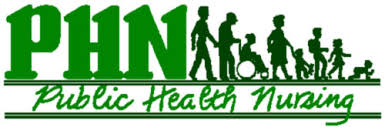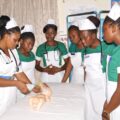What is Public Health Nursing?
Public health nursing is the act of promoting and protecting the health of populations using knowledge from nursing, social, and public health sciences. Public health nursing is a major practice within nursing and public health.
It focuses on improving population health by stressing prevention and attending to multiple determinants of health. Often used in place of community health nursing, this nursing practice includes advocacy, policy development, and planning, which deals with issues of social justice.
Learn how you can also build a career as a public health nurse
Public Health Nurse Intervention
Public health nursing is aimed at improving the health outcomes of all populations.
Public Health Nursing Activities and Practice Settings. Public health nursing activities include the domains depicted by the Public Health Intervention Wheel and the 10 Essential Public Health Services. Some of these activities include community collaboration, health teaching, and policy development, in response to priorities obtained from ongoing, population focused assessment.
Public health nurses are leaders and members of inter-professional teams in different settings and in many different types of agencies and firms including all levels of government, community-based and other non-governmental service organizations, foundations, policy think tanks, academic institutions and other research bodies. Increased number of public health nurses work in global health in an effort to improve and emphasize global responsibility and connectivity.
Public health nurses that work specifically with individuals and families do so within the context of a population focus— applying a systems perspective to factors that affect health.
The Role of a Public Health Nurse
Public health nursing pays attention to the health of entire populations or communities. PHN services are made available to individuals and families within the context of the health of the larger community (society). PHN deals majorly in the promotion and protection of health and the conscious efforts made to prevent disease.
PHNs have the understanding that the health of individuals and communities directly relates to the determinants of health such as income, housing, education, employment, sanitation and safety.
The practice of PHN seeks to improve the health of all people and reduces health differences among populations by addressing determinants of health. PHNs understand that equity is a major aspect of the determinants of healthy living.
Public Health Nurse Competencies
PHNs are general practitioners with skill and expertise in areas such as communicable diseases, maternal-child, and school health. PHNs’ offer services within a community-based model. Services are stimulated by the needs and resources of a defined setting (community).
PHNs’ work with and not on communities. PHNs have skills, expertise, and experience in assessing community assets and needs, in programming, planning and implementing community development strategies combined with a broad base of knowledge related to health and determinants of health.
Nurses operating in the public health sector do have a major responsibility for implementing legislated services to monitor health hazards and communicable diseases as found in The Public Health Act, the Diseases, and Dead Body Regulation and the Food and Food Establishment Regulation.
PHN practice is client-centered and includes the strategies of enabling, empowering, advocating, co-operating and collaborating when working with individuals, communities, and colleagues both within the health system and within other sectors.
PHNs invest long term in health approach. A focus on health and wellness, rather than illness, is the determining factor of all PHN work. PHN services are dynamic in that their contributions are offered in an organized system of healthcare delivery. See Where Public Health Nurses Work And How Much They Earn
This is average level professional nursing work in providing preventive, primary, and rehabilitative care to individuals and families through Public Health programs.
Employees on their own demonstrate and implement techniques of nursing care and counsel for increased promotion of health and prevention of disease through outreaches and seminars in homes and schools respectively, serving in their capacity as team leader for a sub-group within a larger project and/or serving as charge nurses in health institutions (Clinics).
Other employees will be required to help in data collection and review in any project that they are involved in. Other employees at this level will spend at least 25% of their time in one, two or more of the following roles:
Serve as nurse in charge in one or more clinic settings: Their responsibilities include coordinating and/or directing the work done during the clinic hours, assigning responsibilities to lower-level staff accordingly, organizing/managing clinic flow, and advising other clinic staff about management of patient situations that are unfamiliar. Employees may on their own; manage nurse-screening clinics held outside of the health department, requiring strong patient assessment skills.
Provide community outreach services: by making home visits for the purpose of case management or any other nursing activity that functions independently outside of the agency. Other employees (staffs) in these roles carry a caseload of patients and/or families and work in partnership with them to identify strengths and needs and develop a plan for health maintenance or improvement. Employees are required to provide a combination of case management and nursing assessment to enable patients and families manage health care needs. They make referrals to medical facilities, social service agencies, etc. especially when necessary and agreed on by the patient or family. Employees take the role of leadership in coordinating all plans and resources for these clients.
Provide School Health or Child Care Health Consultation services: Employees functioning in these roles are required to work with the administration of the school or child care facility to create goals, do assessments of children when requested, assure that care plans are set in motion for children with potentially serious chronic or recurrent health problems, teach school staff how to carry out skilled procedures, and assure that policies are set in motion for safe medication administration. They also explain health information to students, staffs and parents.
Work with considerable independence: in a community-based health promotion project that has to do with developing programs or support groups, that promote community advocacy, and improving strong partnerships with residents. They serve as leaders of team by organizing and supervising the work assignments and quality of services to be rendered by a small team of lower-level nurses and sub-professionals that make up part of a subgroup of a full project. These other employees have limited administrative and personnel duties; unusual situations and problems are discussed with and/or referred to a higher level supervisor.
Other responsibilities may include coordinating a program-level support activity, such as In-service or quality assurance; participating actively in program or agency-wide planning and quality assurance activities; participating in public health preparedness activities as directed and required by agency management.
The Responsibilities of the Public Health Nurse.
(a) In long-term care
(b) In primary care
(c) In working with specific population groups
(d) In providing a range of services for people living in a specific area.
Responsibilities of the Public Health Nurse in Long-Term Care
At a certain period, the diagnostic category in which the nurse worked most often was the area of tuberculosis control and other infectious diseases.
Although patients are not often hospitalized now for tuberculosis, it remains a major health problem. In the early 1970s the Miami Veterans Administration Hospital decide to start a nurse-managed intermittent therapy clinic for patients with tuberculosis who required extra attention in order to remain on the therapeutic regimen.
The reason for this program included reducing as much as possible the need to re-hospitalize the patient, keeping the patient non-infectious, and maintaining the patient in treatment as long as it was medically required.
The nursing care was headed by the community health nurse and also included teaching the patient about the disease, as well as obtaining all the necessary information for the department of health’s communicable disease records.
The study carried out at the Miami Veterans Administration Hospital, consisting of 15 patients who were examined twice a week by nurses in nurse-managed clinics over an average period of six and a half months, provided initial proof that the nurse-managed clinics were more effective. During the two-year period of the pilot study, none of the 15 patients were hospitalized for tuberculosis and none of them had sputum specimens that were positive for the bacillus after they were discharged from the hospital.
Eleven of the patients completed the prescribed regimen and were transferred to the regular follow-up clinic, one was lost to follow-up, died from an unrelated condition, and two continued in the clinic.
This important study gives some evidence that nurses are able to monitor vital signs, give anti-tuberculosis drugs and observe for side effects, keep the tuberculosis registry, and refer the patient for medical care when indicated. Most important, patients so managed appear to remain with the treatment and so to benefit themselves as well as society.
Responsibilities of the Public Health Nurse in Primary Care
There are various definitions of primary care as there are several speakers and writers on the subject. A comprehensive, all-encompassing definition which everyone agrees upon has not yet been devised.
For the purpose of this article, however, the definition approved by the American Academy of Nursing is used. This definition makes explicit two dimensions in primary care:
- The person’s initial contact with the health delivery system in any given episode of illness, which leads to a decision of what must be done to solve the problem, and
- The added responsibility for the continuum of care, including the maintenance of health, the evaluation and management of conditions, and referral of the patient to other health personnel or agencies.
Making available primary care is a complex process that involves the determination of the basic health services to be provided by different health professionals. The interests and background of community nurses are particularly relevant to the needs of patients for primary care.
A comprehensive examination of the state of Virginia as to the reasons that patients demand the care of family physicians revealed that physicians are asked most of the time to carry out tasks other than that of the curer of disease. People who are in pain, troubled, and or disabled want to see someone with whom they can share their burdens and troubles. Most of them are lonely, so they visit the clinic, the doctor’s office, or the emergency room of the hospital.
Most of the time, what they really seek is sympathy, encouragement and reassurance. Also, most of the patients in the Virginia study wanted care for health supervision and health maintenance, an observation curled up from another study of patient’s needs.
All of these services, as much as they are beneficial for the patient, have countless times led to the aggravations of health care costs by clustering the system of delivery with the result that people who are really in need of the physician’s time are not able to be seen as quickly as their conditions demand.
The medically approved mode of management of the most common occurring problems that are brought to the primary care practitioner may not be complex, but as long as there is the space within the health delivery system to know the difference between mild problems leading to patient discomfort and the problems that seem to be very serious, care can be provided to those with mild problems that is not too expensive, quite accessible, and even more satisfying to the patients.
Normally, primary health care ought to include all of the health care maintenance processes and activities that are included in traditional community health nursing.
Responsibilities of the Public Health Nurse in Working with Specific Population Groups
For quite some time, public health nurses have directed all of their attention to high risk people: the young, the elderly, and the pregnant. Furthermore, all people irrespective of age face more risk if they are poor and do not have access to the required medical care.
One paramount population group that has enjoyed the benefits of increased health services via the Head Start programs is the high risk preschool group. The main aim of Head Start health programs is primary prevention via health care promotion lectures/programs, through health precautions and practices such as immunizations, and also through tooth fluoridation in places where the water is not fluoridated.
Secondary prevention via early diagnosis of disease and treatment of abnormalities has proven successful in these programs. Enlarging the functions of case-finding and referrals to public health agencies, which are duties carried out by all public health nurses.
The shortage of doctors within the health department structure and the already established effectiveness of the community health nurse has greatly led to the early acceptance of the PNP in this role.
The PNP has the ability to establish branch clinics to expand the outreach of the main health care delivery site and is also able to make an in-depth evaluation of the child and the family.
These said qualities have greatly led to an increase in the availability of health care in more sparsely populated places. School nurse practitioners are trained to evaluate and assess children’s health status and to provide them with proper health care by managing a number of health problems including the more common pediatric illnesses and also complex issues. They can also
- Provide well-child care with an emphasis on prevention,
- Integrate care through participation in formulating and implementing plans involving the family, school, and community,
- Foster health education through participation with other school personnel in the prevention of disease and maintenance of health, and
- Assist parents to learn about health problems and assume responsibility for maintaining their children’s health care.
In Galveston, Texas, improved access to community health care was achieved through two changes in the secondary school health services:
- The upgrading of the educational training of school nurses to include pediatric nurse practitioner training and
- More efficient management of the school clinics. The latter was accomplished through the employment of a full-time health aide to assist the nurse in collecting data on the three most common complaints-headaches, colds and upper respiratory complaints, and stomachache and other abdominal complaints.
In addition to attempting to improve problem identification and access to health care for adolescents, this approach to high school health services educated students to become more competent and involved in their own health care. See 7 Things a Public Health Nurse Should Not Do
Responsibilities of the Community Health Nurse in Providing Services for Persons Living In a Specific Area
The nurse as a primary care provider for a geographically isolated group of people was first introduced into rural southeastern Kentucky more than 50 years ago by the Frontier Nursing Service (FNS).
The aim was to establish and maintain a health care system in medically underserved areas; the nurse-midwife was selected as the most appropriately prepared health care provider for meeting the problems of the rural areas. She was more easily attainable at less cost than was the physician.
She could manage the common day-to-day health problems encountered by a family and could take care of the mother throughout the childbearing period and later care for the newborn infant.
She was prepared in health teaching and in public health. On the whole, this is still true in some sparsely populated areas of the country; mobile units staffed by community health nurses provide clinic care, particularly to preschool children. Recruiting health professionals into smaller and more geographically distant areas continues to be a major problem in health delivery.
With the legislation allowing direct reimbursement for nurse practitioners who serve rural areas, predictably more nurse practitioners will practice in such areas. At least one leader in community health nursing insists that more emphasis must be placed on teaching self-care to clients than on continuing to rely on health professionals to give most of the health care.
Self-care has been defined as a process whereby a person can effectively provide for his or her own health promotion, prevention of illness, disease detection, and treatment. Such care can be provided through the knowledge that many people now possess and with the addition of new skills that can be taught to populations at risk.
The practice of self-care is a return to a very old practice and concept: like other aspects of survival and social development, self-care was at one time an individual responsibility. In addition to the importance of reducing reliance on physicians, the major long-term health problems, particularly the problems caused by the degenerative diseases, require constant self-monitoring.
Results of one study suggested that compliance with medical regimens may not be as desirable as is consistently believed by health professionals. In this investigation, patients with compliant, non-questioning attitudes were shown to be unable to cope with their problems, and this may have had a detrimental effect on recovery.
There is, however, an interesting paradox in connection with self-help activities. Although the economic incentive ought to be a major factor in the rationale for increasing a patient’s self-care competence, only the health maintenance organizations include education of the patient among their benefits. Other examples of nurses working in specific geographic areas include:
(a) The traditional public health district assignments,
(b) Occupational groupings such as industrial units, in which nurses assume responsibility for the entire population employed, and
(c) Camp nursing in which nurses contribute to the welfare of the entire population group.
A change in awareness of the community’s needs for health care services is forcing changes in how and by whom care is being delivered today. The increasing emphasis on primary care, particularly care provided on an ambulatory basis; the increased awareness of the importance of health maintenance and preventive care, including health assessment, counseling, and education; and increased pressure to contain health care costs have all influenced these changes. See Private School Of Nursing In Nigeria
Community health nurses have expanded their roles to include the provision of primary care to people at risk by caring for patients with stabilized chronic health problems and helping them to manage their lives as independently as possible. The focus of community health nursing continues to be on public health, i.e. the provision of health services among people of the community and the encouragement of health-promoting behavior.
These populations include the young, the pregnant, the old, those with specific health problems, the poor, the disadvantaged, and the isolated. See Public Health Nursing Programs: 5 Top Schools in Public Health Nursing





